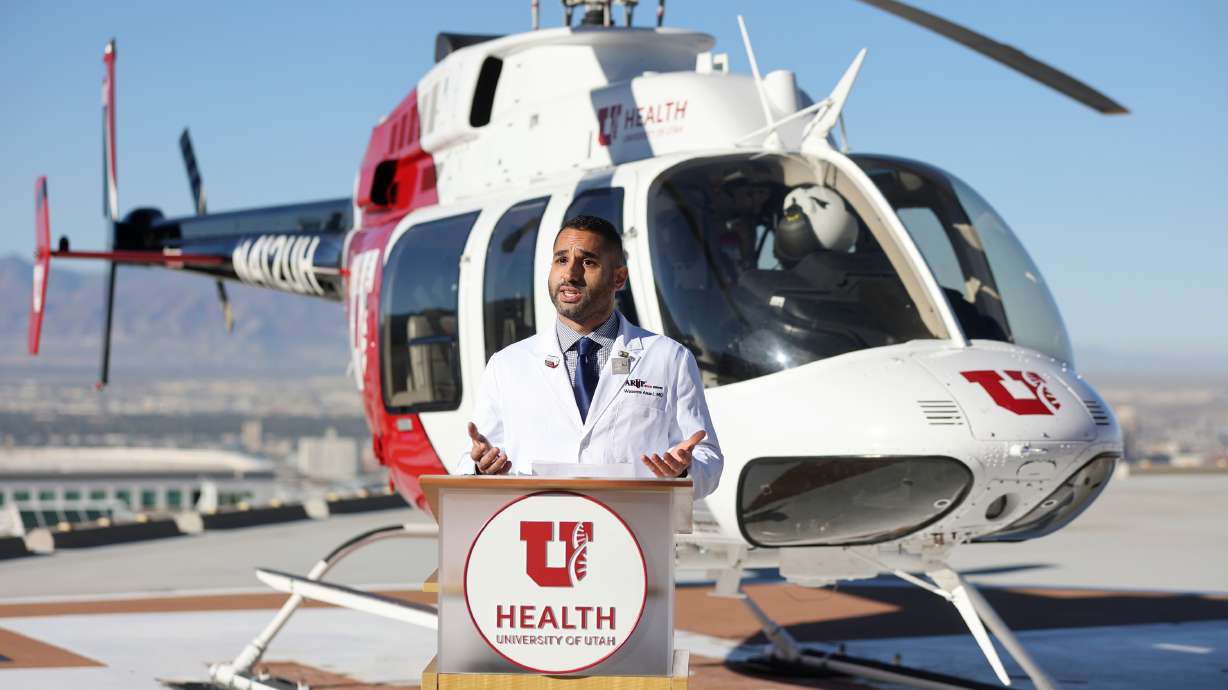Estimated read time: 4-5 minutes
This archived news story is available only for your personal, non-commercial use. Information in the story may be outdated or superseded by additional information. Reading or replaying the story in its archived form does not constitute a republication of the story.
SALT LAKE CITY — Utah Olympic bobsledder Bill Schuffenhauer said he had a "tragic accident" after he retired and almost lost his life. His surgeon told him he survived because multiple people donated blood.
"My surgeon said, 'You are one lucky guy. You lost more blood than any other human I know, and you shouldn't be here today,'" Schuffenhauer said during a press conference announcing the Whole Blood Titan Program on Wednesday.
This experience helped him realize the importance of service in the community; he donates blood because he understands it is going to a good cause and could save a life. Schuffenhauer wanted to "lead by example" as one of the first whole blood donors in the Titan program.
The program provides O-positive and O-negative blood that hasn't been separated to people who need blood the most. Historically, blood has been separated into three parts when donated — red blood cells, platelets and plasma.
Donors who sign up for the program are on call to replace any of ARUP's supply of whole blood used in University of Utah hospitals.
Schuffenhauer is a retired three-time Olympian who won a silver medal for bobsledding in the 2002 Salt Lake City Olympics. He is the president of the Utah Olympic and Paralympic Association — and now he is the face of the Titan Whole Blood program at ARUP.
He encouraged everyone to find somewhere to serve, and said this program is a great opportunity for people who qualify.
The Titan program
Dr. Waseem Anani, medical director at ARUP Blood Services, said typically donated blood is split into the three different components to help it save more lives. He said recent studies in the military show that when someone is severely injured, getting blood sooner is very important, and whole blood helps speed up the process.
Anani said whole blood has been used in the military setting, and the success there is starting to inspire civilian use of whole, unseparated blood.
He said those who qualify for the program belong to a select group of people, because they need to have type O blood and have low antibodies — the best blood for emergency transfusions. They will be on call and ready to donate blood when there is a need, Anani said pretty much 24/7.
"These donors are standing by at a moment's notice for a patient that comes in," he said.
ARUP will have bronze, silver and gold levels available to the donors based on the number of times they donate, which is up to six times each year.
Eric Swanson, who directs AirMed, U. Health's air transport program, said the whole blood will also be available in every emergency room and on every helicopter and aircraft so they can start treatment immediately.
Swanson said AirMed covers about 10% of the U.S., and the blood will help them provide "university-level care" before a patient is transported to the hospital.
Doctors share value of whole blood
Toby Enniss, trauma medical director at U. Health, which is supplied with blood through ARUP, said the system has between 400 and 500 level one trauma patients a year; 40% of those need blood at the beginning of their care and 10% require over 10 units of blood.
"With the use of whole blood, we'll be able to have better outcomes as far as saving lives and we'll be able to use less of this scarce and highly important resource," Enniss said.
He shared a story of a 22-year-old who was skiing in Utah and arrived at the hospital "for all intents and purposes already dead" because his heart had stopped due to the loss of blood. The man needed 160 units of blood in the first 18 hours of care because he had injuries to major blood vessels in his abdomen.
He said this man is one example of someone they would not have been able to save without blood donations.
He said trauma is the leading cause of death for people under age 45, so it is the leading cause of "loss of productive life" in the U.S. Within trauma, he said the most common cause of preventable death is blood loss — which means availability of blood product to replace that blood is essential.
He said studies have shown that when they can approximate whole blood, combining the three blood components in equal parts, the outcomes are better. He said the 30-day mortality rate in trauma patients is reduced when whole blood is used.
Dr. Timothy Bahr, University of Utah Health neonatologist, said since the blood first became available on Oct. 11 it has been valuable in the newborn intensive care unit already, as they were able to give whole blood to a baby who was born already needing blood.
He said there are very few places in the country that have started using whole blood, and they are grateful to offer it to their newborn patients.









